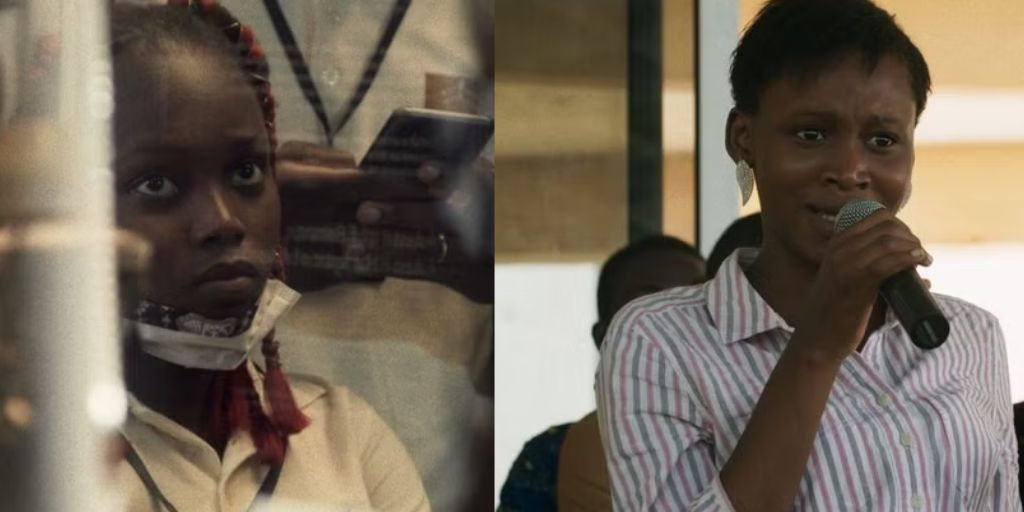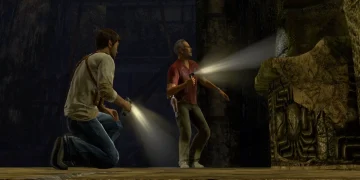In recent years, documentaries have taken many different forms, with some offering fresh ways to present historical events. Some documentaries stick to a formula, giving us a familiar structure: archival footage spliced together with interviews from experts or people connected to the story.
But, with the growing availability of technology used in everyday life, like body cams, CCTV, and personal recordings, new elements are being added to documentary filmmaking, particularly in true crime. These resources have enhanced the presentation of real events, providing viewers with a more intimate and direct experience.
Sometimes, though, recreations of past events can make a documentary feel less serious or even cheap. They can remind viewers of ‘80s true crime shows that aired on cable TV.
However, certain filmmakers are changing the game by mixing fact and fiction, using the techniques of narrative filmmaking to create something more engaging and dynamic. One such filmmaker is Mati Diop, who brings a refreshing approach with her documentary Dahomey, a project that combines historical storytelling with cinematic flair.
Diop’s work won the Golden Bear at the Berlin International Film Festival, an indication of its unique and powerful storytelling. In Dahomey, Diop doesn’t simply retell history. Instead, she merges documentary techniques with narrative filmmaking to create a deep and meaningful portrayal of past and present.
Her approach invites the audience to look closely at how history, memory, and culture are intertwined, particularly through the lens of repatriation—returning cultural artifacts to their places of origin.
What is Dahomey About?
The documentary Dahomey focuses on the repatriation of 26 artifacts to the Republic of Benin in 2021. This country was once known as the Kingdom of Dahomey, a name that may be familiar to those who watched the 2022 historical film The Woman King, starring Viola Davis.
The Kingdom of Dahomey had a rich history, but during the French invasion in 1892, thousands of its cultural treasures were looted and taken to France. These objects were displayed at the Musée du Quai Branly – Jacques Chirac in Paris for over a century.
For many years, the people of Benin have been calling for the return of their cultural artifacts. These items, which include statues of King Glele and King Béhanzin, represent a significant part of their heritage. In 2021, 26 of these objects were finally returned to Benin. Diop’s documentary captures the emotional and historical significance of this repatriation process, offering viewers a look into what it means for a nation to reclaim a piece of its past.
Right from the start, Diop makes it clear that she is not interested in the typical documentary format. Instead of beginning with a long explanation about the Dahomey Wars, French colonization, or the events that led to the artifacts being returned, she uses a single title card to provide the essential information.
From there, the film takes a more visual and meditative approach, moving slowly through the halls of the museum. The camera focuses on the people involved in the repatriation process—security guards, movers, scientists, and anthropologists—without making them the main focus.
The camera also lingers on the artifacts themselves, capturing their beauty in a way that feels respectful and thoughtful. These objects are not glamorized or upgraded beyond their natural form; instead, they are presented as creations of human hands, made with care and artistry, and still standing after centuries of history.
The Artifacts Speak: A Unique Narrative Approach
One of the most interesting elements of Dahomey is the way Diop incorporates an unconventional narrative device: the voice of the artifacts themselves. Throughout the film, there are moments when the screen goes black, and we hear a deep, distorted voice, as if the objects are speaking directly to us.
The voice, which speaks in the Fon language, gives us insight into the thoughts and emotions of the artifacts as they make their journey back to Benin.
This technique is both experimental and evocative. It allows the audience to imagine what these cultural treasures might feel, after having been taken from their homeland and displayed in a foreign land for so long.
The voice of the artifacts describes their thoughts on returning home, expressing uncertainty about whether the place they are going back to is still the same one they left behind.
At one point, the voice says, “I feel far removed from the country I saw in my dreams.” This adds a layer of emotional complexity to the documentary, making the audience think about the relationship between cultural artifacts and the people to whom they belong.
The use of sound design in these moments is particularly effective. The voiceover is accompanied by the sound of nails being hammered and the light slowly fading as the artifacts are sealed in crates for transport. This creates a sense of claustrophobia and confinement, mirroring the objects’ journey from one place to another.
It also gives viewers a deeper connection to the artifacts themselves, as they are no longer just inanimate objects but something more, almost alive with their own memories and histories.
A Joyous Yet Unsettling Homecoming
When the artifacts finally arrive back in Benin, we see real footage of the celebrations that took place. The streets are filled with performers, crowds of people cheering, and a sense of pride and joy. For the people of Benin, the return of these objects represents a victory—a triumph over colonization and a celebration of their enduring culture.
However, Diop does not let the audience settle into the comfort of these happy moments for too long. The voice of the artifacts reminds us that while the objects have come home, things have changed. They speak of feeling alienated, not quite recognizing the land they once called home.
This adds an underlying tension to the film, reminding viewers that the scars of colonization cannot be erased by the return of a few objects. The history of exploitation and theft still lingers, even as the people of Benin celebrate.
The Role of Music in Dahomey: A Tool for Emotional Expression
Throughout the film, Diop uses music to convey the emotional range of the documentary. The score plays an important role, moving between different moods and tones as the film progresses.
In the early scenes, we hear soft, melodic music with the delicate sound of harps, which seems to emphasize the fragility and beauty of the artifacts. This music underscores the care that is being taken to protect and preserve these objects during their journey home.
As the film moves forward, the music shifts. It becomes more electronic, with heavy synth sounds that create a slightly eerie, almost sci-fi atmosphere. This change in tone reflects the strangeness and alienation felt by the artifacts as they narrate their thoughts.
The deep, distorted voice that speaks for the objects adds to this sense of disconnection, making the audience feel as though they are hearing from something far removed from humanity.
Some viewers might find this voice unsettling, and Diop’s choice to make the narrator sound so different from human voices is a deliberate one. It distances the audience from the artifacts, making them seem otherworldly, but it also risks alienating viewers from the beauty and depth of the language being spoken.
A more natural voice might have allowed audiences to connect more closely with the artifacts’ narration, helping them appreciate the vernacular and regional accent of the Fon language.
Conversations on Repatriation: A Look to the Future
The second half of Dahomey takes a more direct and naturalistic approach, focusing on a conversation between students at the University of Abomey-Calavi.
These students are discussing the repatriation of the artifacts, and while they acknowledge that the return of the 26 objects is a positive step, they point out that there is still a long way to go. The students call for the return of all the stolen artifacts—more than 7,000 of which remain in the Paris museum.
Diop captures this conversation in a raw, unpolished way, using a shaky camera that follows the voices of the speakers rather than relying on neat cuts between shots.
This technique makes the discussion feel immediate and urgent, as though it is happening in real-time. It also reflects the ongoing nature of the issues being discussed; the repatriation of cultural artifacts is not a settled matter but a continuing struggle for justice.
Through this debate, Diop reminds the audience that the return of these artifacts is not the end of the story. While it is a victory for the people of Benin, it is also a reminder that much more work needs to be done.
The young people in the film represent the future, and they are determined to continue calling for reparations for the injustices of colonization. Their voices and perspectives offer hope for a more just and equitable future, one in which the cultural heritage of all nations is respected and preserved.
Colonization’s Legacy and a Call for Justice
As Dahomey draws to a close, it confronts the larger issue of colonization’s legacy. The film makes a clear statement about the hypocrisy of colonial powers, who continue to benefit from the exhibition of stolen cultural objects.
These artifacts, which should have been returned to their rightful owners long ago, are still being paraded as symbols of European power and cultural superiority.
The documentary ends on a more somber note than viewers might expect. While the repatriation of the 26 artifacts is undoubtedly a moment of triumph, it is also a reminder of the deep wounds left by colonization. However, there is also a sense of hope.

Diop’s film begins with older French men overseeing the repatriation process, but it ends with the voices of young students, who are committed to creating a more just future. This shift in focus from the past to the future suggests that while there is still much work to be done, the next generation is ready to take on the challenge.
A Dense but Vivid Scheme of History
Dahomey is not a documentary for everyone. Those who are deeply interested in history, anthropology, or the effects of colonization may find it fascinating, but others might struggle to stay engaged during its slower moments.
The film’s experimental style, especially the use of the artifacts’ voiceover, might not appeal to all viewers. However, with a runtime of just over an hour, Diop makes every moment count. She manages to pack centuries of history, injustice, and triumph into a film that is both dense and vivid.
For those willing to immerse themselves in Diop’s unique storytelling approach, Dahomey offers a powerful reflection on the importance of cultural heritage, the enduring impact of colonization, and the ongoing fight for justice and reparations.




